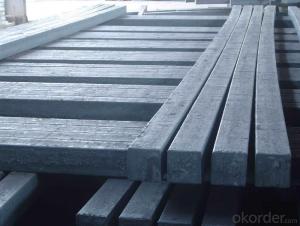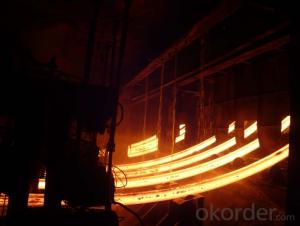Square Steel Billet Q235 3SP Grade Prime Quality 4#
- Loading Port:
- Tianjin
- Payment Terms:
- TT OR LC
- Min Order Qty:
- 2000 m.t
- Supply Capability:
- 50000 m.t/month
OKorder Service Pledge
OKorder Financial Service
You Might Also Like
Description of Square Steel Billet Q235 3SP Grade Prime Quality 4#
M. S. Billets are used for rolling of TMT Re-Bars of Fe415 and Fe500 Grade and various other structural steel products.
CRS Billets are used for rolling of CRS TMT Re-Bars.
Special Alloy Billets are used for rolling of any special grade TMT Re-Bars like Earthquake resistant TMT Re-Bars and for special grade structural steel products.
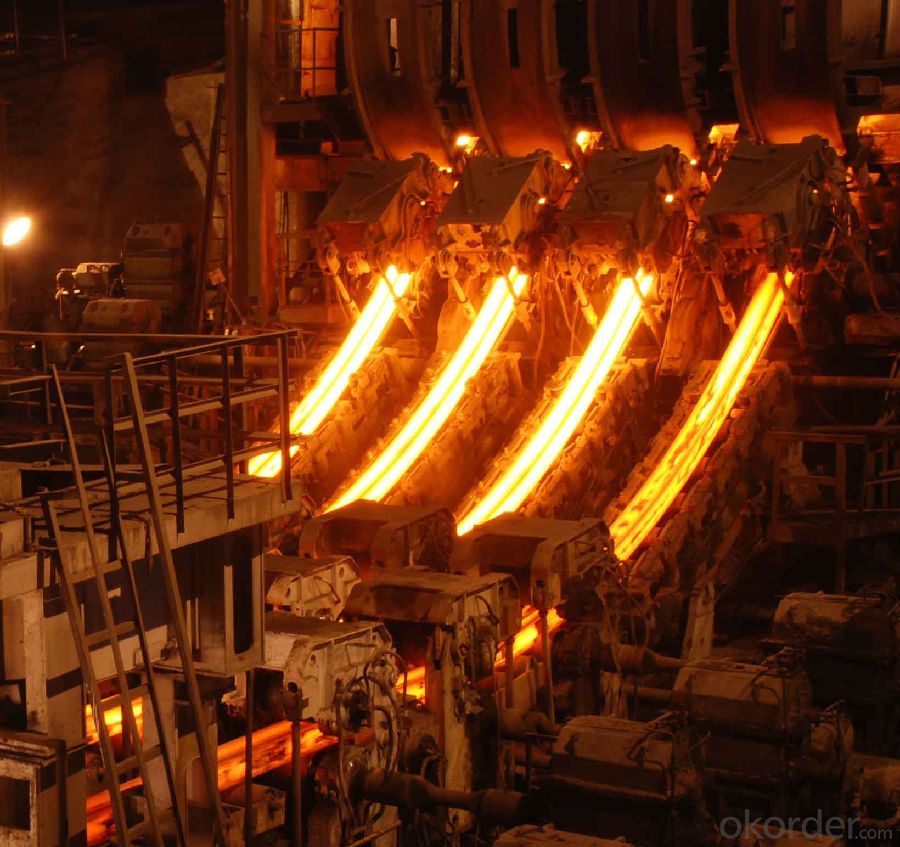
Main Feature Square Steel Billet Q235 3SP Grade Prime Quality 4#
Raw elements(C,Fe,Ni,Mn,Cr,Cu.)---Smelted ingots by AOD finery---hot rolled into black suface---pickling in acid liquid---cold drawn----polished by automatically machine--- cutting into pieces---checking quanlity
Applications of Square Steel Billet Q235 3SP Grade Prime Quality 4#
Widely Used in the areas such as Stainless Steel Fasteners, Chains, Kitchen and Sanitary wares, Furniture handles, Handrails, Electroplating and Electrolyzing pendants, Foods, Electron, Petroleum, Construction and Decoration, etc. Products have a high strength after cold-working. Electronic products parts, Medical appliance, Springs, Bus Inside and Outside packaging and building, Street Lamp Posts, etc. Decoration materials and Outdoor Publicity Billboard. Used for the products which have the Anti-Stress Corrosion requirement. Electron Products, Table-wares, Bolts, Nuts, Screen Meshes, Cumbustors and so on.
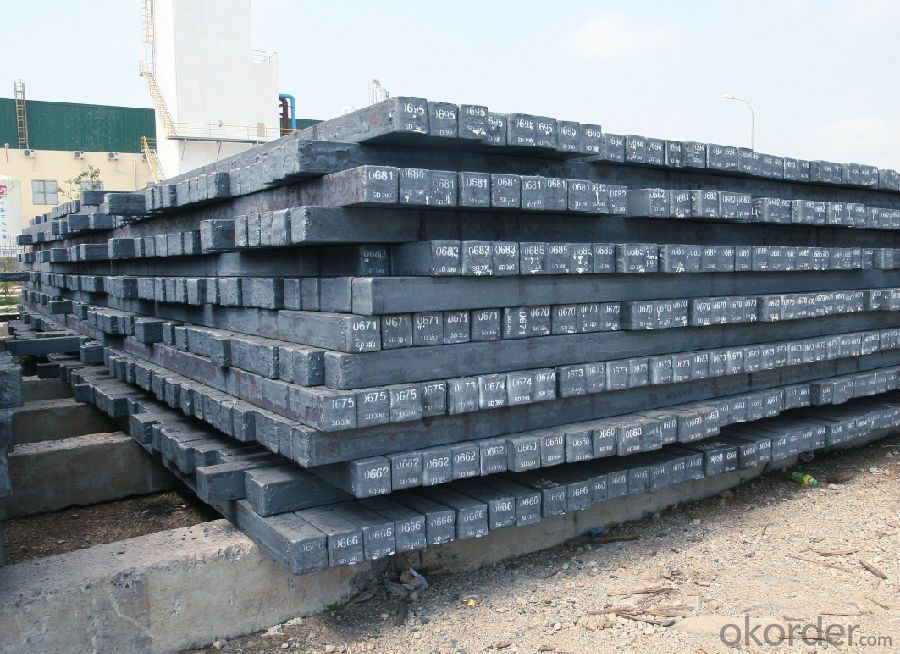
Specifications of Square Steel Billet Q235 3SP Grade Prime Quality 4#
| Standard | C(%) | Mn(%) | S(%) | P(%) | Si(%) |
| Q195 | ≤0.12 | ≤0.50 | ≤0.040 | ≤0.035 | ≤0.30 |
| Q235 | ≤0.20 | ≤1.40 | ≤0.045 | ≤0.045 | ≤0.35 |
| Q275 | ≤0.22 | ≤1.50 | ≤0.045 | ≤0.045 | ≤0.35 |
| 20MnSi | 0.17-0.25 | 1.2-1.6 | ≤ 0.050 | ≤ 0.050 | 0.40-0.80 |
| 3SP | 0.14-0.22 | 0.40-0.85 | ≤ 0.050 | ≤ 0.040 | 0.05-0.15 |
| 5SP | 0.28-0.37 | 0.50-1.00 | ≤ 0.050 | ≤ 0.040 | 0.15-0.30 |
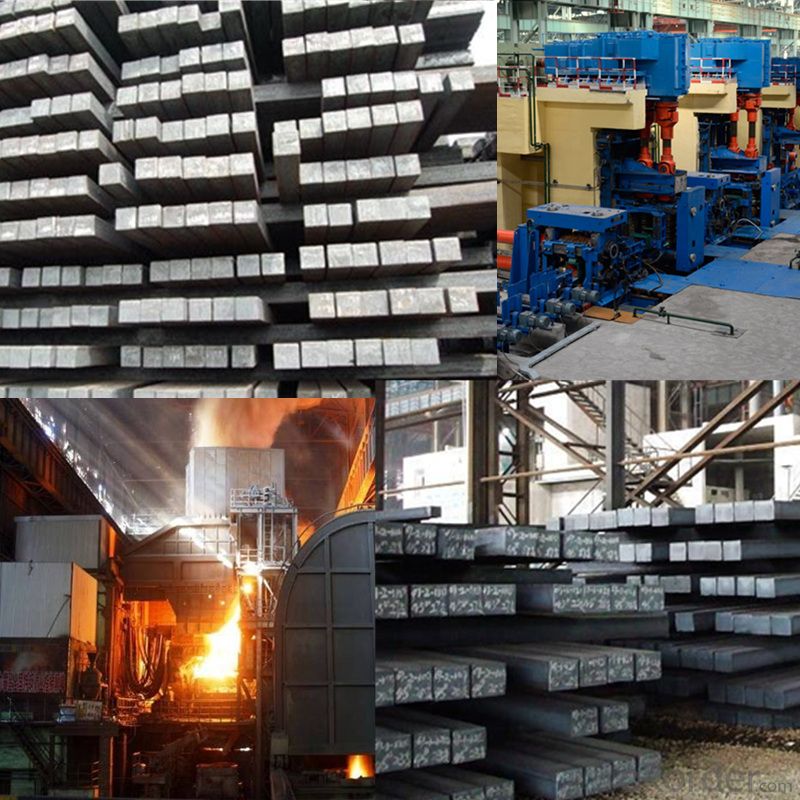
FAQ of Square Steel Billet Q235 3SP Grade Prime Quality 4#
We have organized several common questions for our clients,may help you sincerely:
1. How Can I Visit There?
Our company is located in Tianjin City, China, near Beijing. You can fly to Tianjin Airport Directly. All our clients, from home or aboard, are warmly welcome to visit us!
2. How Can I Get Some Sample?
We are honored to offer you sample.
3. Why choose CNBM?
Our delivery time about 15-20days for standard sizes, if you have other requirements like hardness, quanity and width ,it is about 20-40days. But don't worry we also try our best for the delivery time ,because time longer and our cost is higher.
- Q:Can steel billets be used in the production of utensils and cutlery?
- Utensils and cutlery can indeed be produced using steel billets. These semi-finished products have the potential to be transformed into a variety of shapes and forms, including utensils and cutlery. The remarkable properties of steel, such as its strength, durability, and resistance to corrosion, make it an ideal choice for manufacturing these items. In the production process, steel billets are often melted and cast into specific shapes. They are then further processed through techniques like forging, stamping, or machining to create the desired utensils and cutlery items. The range of final products is extensive, encompassing not only spoons, forks, and knives but also more intricate items like serving spoons, ladles, and cheese slicers. Steel utensils and cutlery are highly regarded and widely used due to their long-lasting nature and hygienic qualities.
- Q:How are steel billets used in the manufacturing of agricultural equipment?
- Steel billets are an integral component in the manufacturing process of agricultural equipment. These billets, which are essentially semi-finished steel products, serve as the raw material for producing various parts and components of agricultural machinery. One of the primary uses of steel billets in agricultural equipment manufacturing is for the construction of the frame or chassis of the equipment. The frame provides the structural integrity and support necessary to withstand the demanding conditions encountered in agricultural applications. Steel billets are often used due to their high strength, durability, and resistance to corrosion, which are crucial qualities required for withstanding the heavy loads, vibrations, and exposure to harsh environments that agricultural machinery often faces. Additionally, steel billets are used in the production of other important components such as axles, gears, shafts, and blades. These components are critical for the proper functioning and performance of agricultural equipment. Steel billets are preferred for these applications due to their machinability, allowing them to be easily shaped and formed into the desired specifications and dimensions required for each component. Furthermore, steel billets are also utilized in the manufacturing of attachments and implements that are commonly used in agricultural operations. For instance, plows, harrows, cultivators, and seeders, all rely on steel billets to provide strength, durability, and resistance to wear and tear. These attachments are often subjected to demanding conditions and need to withstand the forces encountered during field operations. Overall, steel billets play a crucial role in the manufacturing of agricultural equipment by providing the necessary strength, durability, and functionality required for these machines to perform effectively in the agricultural sector. The use of steel billets ensures that the agricultural equipment can withstand the harsh conditions of farming operations, resulting in increased productivity, efficiency, and longevity of the machinery.
- Q:What are the challenges faced in steel billet manufacturing?
- Some of the challenges faced in steel billet manufacturing include achieving consistent quality, maintaining efficiency in production processes, managing energy consumption, ensuring the safety of workers, and addressing environmental concerns. Additionally, market fluctuations and competition can also pose challenges in terms of pricing and demand.
- Q:What is the typical composition of a steel billet?
- The specific grade and intended use of a steel billet can cause its typical composition to vary. Nevertheless, in general, a steel billet primarily consists of iron, carbon, and additional alloying elements. Steel's main constituent is iron, which typically accounts for about 98% of its composition. This element provides the material with structural strength and durability. Carbon, the second most significant element, usually ranges from 0.02% to 2.1% and plays a vital role in determining the steel's hardness and strength. Besides iron and carbon, steel billets often incorporate various alloying elements to enhance specific properties. These elements may include manganese, silicon, nickel, chromium, molybdenum, vanadium, and others. Each element contributes to different characteristics, such as corrosion resistance, heat resistance, toughness, or machinability. Moreover, steel billets are frequently produced through processes like continuous casting or hot rolling, which can introduce small amounts of impurities. These impurities, such as sulfur, phosphorus, and oxygen, are typically maintained at very low levels to preserve the desired quality of the steel. In conclusion, the typical composition of a steel billet comprises a combination of iron, carbon, alloying elements, and minor impurities. These components are carefully regulated to achieve the desired mechanical properties and performance for a wide range of applications in industries such as construction, automotive, aerospace, and manufacturing.
- Q:What are the different welding techniques used for steel billets?
- Some of the different welding techniques used for steel billets include shielded metal arc welding (SMAW), gas metal arc welding (GMAW), flux-cored arc welding (FCAW), submerged arc welding (SAW), and laser welding. Each technique has its own advantages and is chosen based on factors such as the thickness of the billet, desired weld quality, and production requirements.
- Q:How are steel billets inspected for internal defects?
- Steel billets are inspected for internal defects using various non-destructive testing (NDT) techniques. One common method is ultrasonic testing (UT), where high-frequency sound waves are used to detect defects inside the billet. A transducer sends ultrasonic waves into the billet, and the reflected waves are analyzed to identify any internal flaws. UT is capable of detecting defects such as cracks, voids, inclusions, and other discontinuities. Another method employed is magnetic particle inspection (MPI). This technique is particularly useful for detecting surface and near-surface defects in ferromagnetic materials like steel. A magnetic field is applied to the billet, and iron particles are spread over the surface. If there is a defect, the magnetic field will cause the particles to form visible indications, providing a clear indication of any internal flaws. Liquid penetrant testing (PT) is another widely used method for inspecting steel billets. In this process, a liquid dye is applied to the surface of the billet and allowed to penetrate any surface-breaking defects. After a specified time, excess dye is removed, and a developer is applied. The developer draws out the penetrant from any defects, making them visible under proper lighting conditions. Additionally, radiographic testing (RT) can be employed to detect internal defects in steel billets. This method uses X-rays or gamma rays to capture images of the billet's internal structure. The radiation passes through the billet, and a film or digital detector records the transmitted radiation. Any internal defects will appear as shadows on the image, allowing for their identification. Overall, a combination of these NDT techniques is often used to ensure thorough inspection of steel billets for internal defects. This helps maintain the quality and integrity of the billets, ensuring they meet the required specifications and standards.
- Q:Can steel billets be used for making hand tools?
- Yes, steel billets can be used for making hand tools. Steel billets are the initial form of steel that can be shaped and processed into various products, including hand tools. The billets can be heated, forged, and machined to create durable and reliable hand tools that can withstand the rigors of daily use.
- Q:What are the different surface defects that can be found in steel billets?
- There are several common surface defects that can be found in steel billets. These defects can occur during the manufacturing process or due to handling and transportation. Some of the different surface defects that can be found in steel billets include: 1. Scale: Scale is a type of surface oxidation that appears as a thin layer of iron oxide on the surface of the billet. It can occur during the heating and cooling process and can be removed through mechanical or chemical cleaning methods. 2. Cracks: Cracks can occur due to the improper cooling of the billet or excessive stress during handling. They can either be longitudinal or transverse, and their severity depends on the depth and length of the crack. Cracks can weaken the structural integrity of the billet and should be carefully inspected and repaired. 3. Inclusions: Inclusions are particles or impurities that are trapped within the steel during the manufacturing process. They can be non-metallic or metallic in nature and can affect the mechanical properties of the billet. Inclusions can be categorized as slag inclusions, gas porosity, or non-metallic inclusions like oxides and sulfides. 4. Decarburization: Decarburization is a surface defect that occurs due to the loss of carbon on the surface of the billet during the heating process. It can result in reduced hardness and strength of the steel in the affected area. Decarburization can be minimized by controlling the heating and cooling process and using protective atmospheres. 5. Laminations: Laminations are layers or sheets of non-metallic material that are trapped between the layers of steel during the manufacturing process. They can cause weak spots in the billet and can lead to failure under stress. Laminations can be detected through non-destructive testing methods and should be removed or repaired. 6. Pitting: Pitting is a localized corrosion phenomenon that appears as small pits or cavities on the surface of the billet. It can occur due to exposure to corrosive environments or improper storage conditions. Pitting can reduce the lifespan of the billet and should be treated to prevent further corrosion. It is important to note that these surface defects can vary in severity and impact the quality and performance of the steel billet. Regular inspection, testing, and quality control measures are necessary to identify and address these defects to ensure the integrity of the steel billet and the final products made from it.
- Q:What are the common shipping methods for steel billets?
- The common shipping methods for steel billets include container shipping, bulk shipping, and rail transportation. Container shipping is a popular method for transporting smaller quantities of steel billets. The billets are loaded into standard shipping containers, typically 20 or 40 feet in length, and then shipped via cargo vessels. This method allows for easy handling and ensures the protection of the billets during transit. Bulk shipping is commonly used for larger quantities of steel billets. In this method, the billets are loaded directly onto the cargo vessel without the need for containers. This allows for cost-effective transportation of large volumes of billets. Bulk carriers are specially designed to handle heavy cargo and ensure secure delivery. Rail transportation is another common shipping method for steel billets, especially for domestic or regional transportation. The billets are loaded onto specialized railcars, capable of carrying heavy loads, and transported via rail networks. This method offers efficient and reliable transportation, particularly for shorter distances. Ultimately, the choice of shipping method for steel billets depends on factors such as quantity, destination, cost, and logistical capabilities. Each method has its own advantages and considerations, and it is crucial to select the most suitable option based on the specific requirements of the shipment.
- Q:What are the common testing methods used for quality control of steel billets?
- There are several common testing methods used for quality control of steel billets. These methods ensure that the billets meet the required specifications and are suitable for further processing. 1. Visual Inspection: This is the initial step in quality control, where the billets are visually inspected for any surface defects such as cracks, seams, or discontinuities. 2. Dimensional Inspection: Billets are measured using various instruments to ensure they meet the specified length, width, and thickness requirements. 3. Ultrasonic Testing (UT): This non-destructive testing method uses high-frequency sound waves to detect internal defects in the billets. UT can identify defects such as inclusions, voids, or cracks that are not visible to the naked eye. 4. Magnetic Particle Inspection (MPI): This method involves magnetizing the billets and applying iron particles to detect surface and near-surface defects. Any defects will cause the particles to gather, indicating the presence of a defect. 5. Dye Penetrant Inspection (DPI): It involves applying a liquid dye to the surface of the billets, which seeps into any surface cracks or defects. After a certain time, excess dye is removed, and a developer is applied to make the defects visible. 6. Hardness Testing: This method measures the hardness of the billets using various techniques like Rockwell, Brinell, or Vickers hardness testing. It helps determine the billet's strength and resistance to deformation. 7. Chemical Analysis: Chemical composition analysis is conducted to ensure that the steel billets meet the required chemical specifications. This is done using spectroscopic techniques like Optical Emission Spectroscopy or X-Ray Fluorescence. 8. Microstructure Examination: A microscopic examination is performed to study the microstructure of the steel billets. It helps determine the grain size, presence of inclusions, and overall quality of the steel. By employing these testing methods, manufacturers can ensure the quality and reliability of steel billets, which in turn guarantees the safety and performance of the final steel products.
1. Manufacturer Overview |
|
|---|---|
| Location | |
| Year Established | |
| Annual Output Value | |
| Main Markets | |
| Company Certifications | |
2. Manufacturer Certificates |
|
|---|---|
| a) Certification Name | |
| Range | |
| Reference | |
| Validity Period | |
3. Manufacturer Capability |
|
|---|---|
| a)Trade Capacity | |
| Nearest Port | |
| Export Percentage | |
| No.of Employees in Trade Department | |
| Language Spoken: | |
| b)Factory Information | |
| Factory Size: | |
| No. of Production Lines | |
| Contract Manufacturing | |
| Product Price Range | |
Send your message to us
Square Steel Billet Q235 3SP Grade Prime Quality 4#
- Loading Port:
- Tianjin
- Payment Terms:
- TT OR LC
- Min Order Qty:
- 2000 m.t
- Supply Capability:
- 50000 m.t/month
OKorder Service Pledge
OKorder Financial Service
Similar products
New products
Hot products
Related keywords



